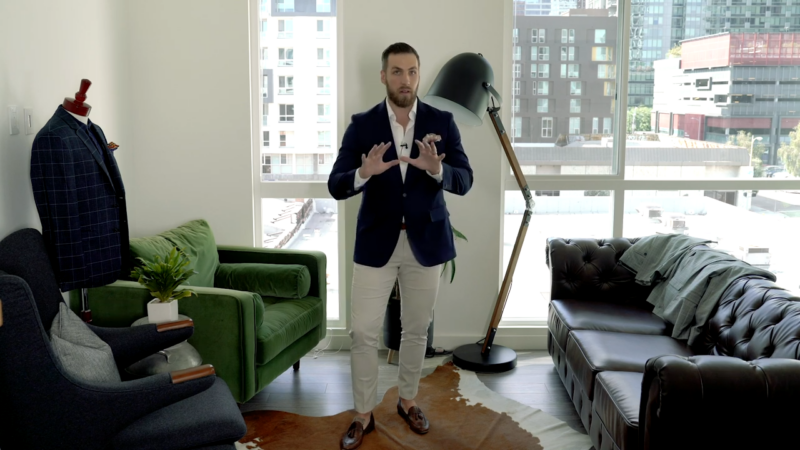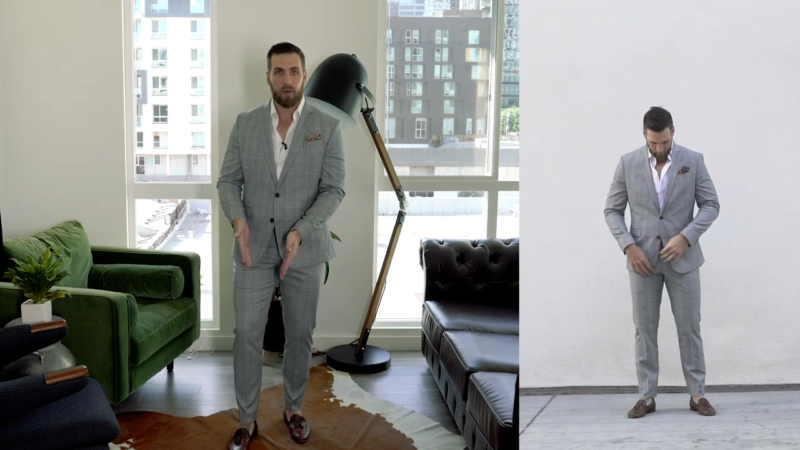A perfectly fitting suit enhances confidence and leaves a lasting impression in any situation. Men’s suits serve as an investment in style and personal expression. Numerous options exist, and navigating them may seem overwhelming. The journey to finding the right suit should be enjoyable and straightforward.
This guide clarifies the different tailoring options available, ensuring an understanding of each choice and how it contributes to achieving the ideal fit. Preparing for a wedding, an important meeting, or a special occasion requires knowing your options. Knowledge serves as the first step toward a suit that looks and feels exceptional.
Jacket Style
Single-Breasted, Double-Breasted
Single-breasted suits are versatile; double-breasted suits add formality and structure.
Fit
Slim, Regular, Relaxed
Slim fits are sleek but snug; regular fits are classic; relaxed fits offer more comfort.
Sleeve Length
About half an inch of shirt cuff showing
Ensures a polished look without appearing too long or too short.
Suit Construction
Fused, Half-Canvassed, Full-Canvassed
Fused is budget-friendly; half-canvassed offers a balance of quality and cost; full-canvassed provides the best drape and longevity.
Fabric
Wool, Cotton, Linen, Blends
Wool is versatile; cotton suits are breathable; linen works for summer; blends offer specific benefits like durability.
Trousers Fit
Slim, Regular, Relaxed
Choose based on comfort and style preference. Slim is modern; regular is timeless; relaxed is for ease of movement.
Trousers Front
Pleated, Flat Front
Pleated adds room around the hips; flat front offers a clean, contemporary look.
Shoes
Oxford, Derby, Loafers, Monk Straps
Oxfords are formal; Derbies are versatile; loafers suit casual settings; monk straps make a bold statement.
Figure Out Your Ideal Suit Style and Fit
When starting your journey to find the perfect suit, the first step is to understand the style and fit that best suits you.
Think About the Occasion

Decide where and how you’ll be wearing your suit. Is it for daily work, a wedding, or a special social event? Different occasions require different levels of formality. For example:
- Business Suits: Typically conservative, with darker colors like navy, charcoal, or black. Ideal for meetings, interviews, or day-to-day office wear.
- Wedding Suits: More room for creativity with colors and fabrics. If the event is outdoors or in a warmer climate, lighter fabrics like linen or cotton may be a better fit.
- Social Events: Suits for evening parties or galas can be bold, with patterns or velvet options for a standout look.
Single-Breasted vs. Double-Breasted
- Single-Breasted: The more versatile option, with one column of buttons. Works well in both professional and social settings. It is easier to wear and fits most body types, making it a classic choice.
- Double-Breasted: Features two columns of buttons, with a more structured and formal appearance. If you want to make a statement, this is the way to go, but it’s less forgiving on various body shapes and more challenging to pull off in casual settings.
Finding the Right Fit for Your Body
There are three main fit types to consider:
- Slim Fit: Snug through the shoulders, chest, and waist, with tapered trousers. Great for a modern, sleek look but may feel restrictive if you have a more athletic or broad build.
- Regular Fit: Offers a classic shape with room for comfort. It drapes more naturally and works well for those who prefer a timeless style.
- Relaxed Fit: Extra room for movement. This is ideal for comfort and a more laid-back style, though it might appear too loose for formal settings.
Suit Elements You Need to Think About
- Shoulder Fit: The shoulder pads should lie flat and align with your natural shoulder line. Any bulging or sagging indicates an improper fit.
- Chest and Waist: You should be able to close the jacket comfortably without any pulling or bunching. Aim for enough room to fit a closed fist between your chest and the suit when buttoned.
- Jacket Length: The hem of the jacket should cover your backside without extending too far down. It needs to strike the right balance, creating an elongated, clean leg line.
- Sleeve Length: The sleeves should reveal about half an inch of your shirt cuff. Too long, and it looks sloppy; too short, and it seems like you’ve outgrown your suit.
- Trousers: For a sharp look, consider a slight break, where the fabric just touches the top of your shoes. A full break can be more traditional but risks looking baggy.
Check out our review of Jos. A. Bank Dress Shirts.
Choosing the Right Suit Construction and Fabric
Understanding the construction and fabric of your suit is crucial.
Here is what you need to know:
Suit Construction
Suit construction defines the way your jacket is built.
There are three primary types:
1. Fused Construction
- What It Is: The cheapest and fastest method, where the inner lining is glued to the outer fabric.
- Pros: Affordable and holds a crisp shape initially.
- Cons: Over time, the glue can break down, causing bubbling and a less natural drape. It doesn’t mold to your body as well as other methods.
- Best For: Entry-level suits or when budget is a major concern.
2. Half-Canvassed Construction
- What It Is: Combines both fusing and canvassing. A thin layer of canvas is sewn into the upper part of the jacket (from the chest to the shoulders), while the lower half is fused.
- Pros: Offers a better fit and shape than fused construction. It provides a more natural drape and improved durability.
- Cons: More expensive than fused suits but generally worth the investment.
- Best For: People looking for a balance between quality and cost.
3. Full-Canvassed Construction
- What It Is: The highest quality option. The entire front of the jacket is lined with a layer of canvas, which is sewn, not glued, to the fabric.
- Pros: Molds perfectly to your body over time, creating a natural, elegant drape. It ages well, becoming more comfortable the longer you wear it.
- Cons: The most expensive and time-consuming to make.
- Best For: Those investing in a lifelong suit, high-profile events, or those who want nothing but the best.
Choosing the Right Fabric
@natalino.co Tropical wool suit #classicmenswear #mensfashion
Wool
Versatile and Durable
Types
- Tropical Wool: Lightweight for warm weather.
- Merino Wool: Soft and luxurious, often used for high-end suits.
- Flannel Wool: Thicker and best for colder weather.
Best For
Cotton
- Breathable and Casual: Cotton suits are less formal and perfect for summer or daytime events. They offer a relaxed, natural look.
- Pros: Breathable and comfortable in warm weather.
- Cons: Wrinkles easily and doesn’t have the same refined drape as wool.
- Best For: Casual or business-casual settings.
Linen
- Lightweight and Airy: Linen suits are a go-to choice for hot climates and outdoor events. They offer excellent breathability.
- Pros: Keeps you cool in heat and has a unique, laid-back charm.
- Cons: Prone to wrinkling and can lose shape easily.
- Best For: Summer weddings, beach events, and relaxed social gatherings.
Blends
- Mixed Materials: Suits made from fabric blends (like wool-silk or cotton-polyester) aim to combine the best traits of each material.
- Pros: Can be more affordable, durable, or wrinkle-resistant, depending on the blend.
- Cons: Quality varies, so be sure to feel the fabric before buying.
- Best For: Everyday wear or if you’re looking for a specific fabric quality.
Picking Suit Colors Based on the Occasion
- Navy: A versatile choice that works for business, weddings, and most events. It pairs well with a variety of shirts and ties.
- Charcoal Gray: Another staple that exudes professionalism and is suitable for nearly any occasion.
- Black: Best reserved for formal events like black-tie affairs. Avoid wearing black suits to work unless you are in a very formal environment.
- Lighter Colors: Think tan, light gray, or pastel shades. These are ideal for spring and summer but keep in mind that they are less formal.
Lining Material and Its Impact
Lining enhances the suit’s structure and comfort. The two most common options are:
- Silk: Luxurious and smooth but expensive. It adds a touch of elegance.
- Bemberg: A type of rayon, more affordable and breathable, making it a popular choice for quality suits.
Customize Your Suit to Match Your Personality
Sieh dir diesen Beitrag auf Instagram an
Lapel Styles – Making a Statement
The lapel style you choose significantly influences the overall vibe of your suit. Here are the main options:
Notch Lapel
- Classic and Versatile: The most common lapel, ideal for business suits and less formal occasions. It features a cut-out or “notch” where the collar meets the lapel.
- Best For: Everyday suits, job interviews, and professional settings.
Peak Lapel
- Formal and Bold: This lapel type points upwards and is more prominent. It is often found on double-breasted suits or tuxedos, adding an element of power to your outfit.
- Best For: Formal events, weddings, or when you want to stand out.
Shawl Lapel
- Elegant and Smooth: A continuous, rounded lapel with no breaks or cuts. Commonly seen on tuxedos, this style exudes sophistication.
- Best For: Black-tie events and evening wear.
A Pinstripe Suit can also be a perfect option.
Buttons – Small Details, Big Impact
Buttons may seem like a small detail, but they have a big impact on the suit’s appearance and functionality.
Front Buttons
- One Button: Found on formal evening suits and tuxedos. Creates a sleek look but limits versatility.
- Two Buttons: The standard for most modern suits, offering a balanced look suitable for nearly any occasion.
- Three Buttons: Less common today but still seen in traditional or retro suits. Works well for taller men.
Sleeve Buttons
The number of buttons on your jacket’s sleeve is typically between three and four.
Pockets – Functionality Meets Style
Suit jackets come with different pocket options, each adding a unique touch to the overall design.
Flap Pockets
- Standard and Practical: A pocket covered with a flap of fabric. Works well for business and everyday suits.
- Best For: Most occasions and styles.
Jetted Pockets
- Minimal and Formal: Sewn into the jacket without a flap, giving a clean, seamless look. Perfect for tuxedos and dressy suits.
- Best For: Black-tie events and formal attire.
Patch Pockets
- Casual and Relaxed: Pockets sewn directly onto the jacket’s exterior. These add a laid-back vibe to blazers and less formal suits.
- Best For: Casual gatherings or smart-casual outfits.
Additional Customization Options
- Lining Color and Pattern: The inside of your suit jacket can be as bold or subtle as you wish. Go for a bright, patterned lining to add a pop of personality, or keep it simple for a classic touch.
- Pick Stitching: A subtle, decorative stitch running along the edges of your lapel and pockets. It adds a touch of craftsmanship to the suit.
- Monograms: Personalize your suit by having your initials monogrammed inside the jacket or on the cuff. It’s a discreet way to claim your style.
How to Pick the Right Trousers for Your Suit?
Trousers are a crucial part of any suit. They affect both your style and comfort. Here is how to select the perfect pair.
The Right Fit
Choosing the correct fit makes all the difference.
Here are the main options:
1. Slim Fit
- Tapers from the thigh to the ankle, giving a sharp, modern appearance.
- Works best for lean or athletic builds.
- Be cautious of styles that are too tight, as they can limit movement.
2. Regular Fit
- Provides a classic shape with plenty of room for comfort.
- Suitable for most body types and has a timeless appeal.
- Ensure the waistband fits well without requiring a belt for support.
3. Relaxed Fit
- Offers more space for maximum comfort.
- Ideal for larger builds or if you prefer a more laid-back style.
- Make sure there is no extra fabric pooling around the ankles.
Pleats or a Flat Front
Choosing between pleats and a flat front can change the look and feel of your trousers:
Pleated Trousers
- Feature folds at the waistband, adding extra room around the hips.
- More comfortable when sitting down.
- Suitable for men with fuller thighs or anyone who favors a classic design.
Flat Front Trousers
- Smooth and clean, with no additional folds.
- Offer a sleek, contemporary appearance.
- Great for a minimalist and modern look, especially on slimmer builds.
Waistband Styles
Sieh dir diesen Beitrag auf Instagram an
How your trousers stay up affects both style and comfort:
Belt Loops
- Practical and standard, allowing for the use of a belt.
- Ideal for business-casual or more relaxed outfits.
Side Adjusters
- Built-in straps that let you adjust the fit without a belt.
- A polished choice for a sleek, belt-free appearance.
Suspenders (Braces)
- Attach to buttons on the inside of the waistband.
- Provide a vintage and classic feel while keeping trousers securely in place.
Hem and Cuff Options
The finish at the bottom of your trousers can add the final touch:
Hemmed
- A plain finish at the bottom, offering a clean, simple look.
- Best for a modern and minimalistic style.
Cuffed
- The fabric folds back and is sewn, adding weight and structure.
- Common in traditional suits and adds an elegant touch.
The Right Shoes to Match Your Suit
Shoes complete your suit and define your overall appearance. They play a vital role in adding the perfect finishing touch. Here is how to select the right pair.
Types of Dress Shoes
Different styles of dress shoes work best for various occasions.
Here are the main types:
1. Oxford Shoes
- Description: The most classic and formal option, with a closed lace system.
- Best For: Business meetings, formal events, and black-tie settings. Ideal for dark, traditional suits.
- Tip: Keep them polished and in good condition to maintain a refined appearance.
2. Derby Shoes
- Description: A more casual choice, with an open lace system that provides extra comfort.
- Best For: Business-casual attire or less formal suits. Suitable for daily office wear.
- Tip: Versatile and practical, making them great for long hours.
3. Loafers
- Description: Slip-on shoes that come in styles like penny loafers or tassel loafers.
- Best For: Smart-casual outfits, summer suits, and relaxed settings. Pair well with lighter-colored suits.
- Tip: Suede loafers give off a casual feel, while leather options suit dressier occasions.
4. Monk Straps
- Description: Shoes with one or two buckles instead of laces, giving a bold and stylish look.
- Best For: Business or formal settings when looking to make a statement. Pairs well with tailored suits.
- Tip: Double monk straps catch more attention, while single straps offer a more understated look.
The Right Color for Your Shoes
- Black Shoes: The most formal option, perfect for black, charcoal, or navy suits. They work best for business and formal events.
- Brown Shoes: More versatile and range from light to dark brown. Suitable for navy, gray, or lighter-colored suits.
- Burgundy Shoes: Add a unique touch to your outfit. Match well with navy or gray suits but avoid pairing with black.
- Tan Shoes: Ideal for summer suits or less formal events. Complement blue and light gray suits well.
Tips for Pairing Shoes with Your Suit
- Match Your Belt: Always wear a belt that matches the color and material of your shoes to maintain a cohesive look.
- Choose the Right Socks: Go for socks that match your suit or shoes. For added personality, consider a pop of color when appropriate.
FAQs
Final Words
Finding the right suit should feel effortless and rewarding. A good suit reflects your style, boosts your confidence, and elevates your presence. Focus on fit, fabric, and construction to ensure you invest in a suit that suits you well for any occasion. Take pride in the details, and remember: a thoughtful choice always leaves a strong impression.

